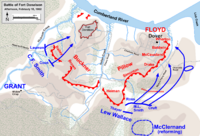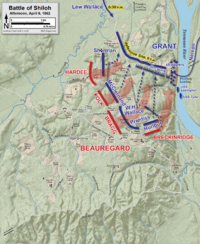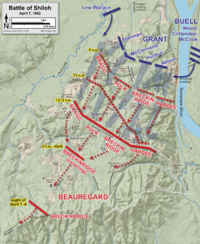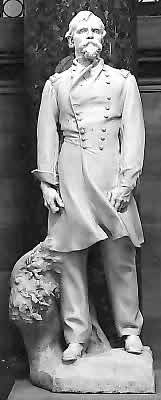Lew Wallace facts for kids
Quick facts for kids
Lew Wallace
|
|
|---|---|
 |
|
| 11th Governor of New Mexico Territory | |
| In office September 29, 1878 – March 9, 1881 |
|
| Appointed by | Rutherford B. Hayes |
| Preceded by | Samuel Beach Axtell |
| Succeeded by | Lionel Allen Sheldon |
| United States Minister to the Ottoman Empire | |
| In office September 6, 1881 – May 15, 1885 |
|
| President | James A. Garfield Chester A. Arthur Grover Cleveland |
| Preceded by | James Longstreet |
| Succeeded by | Samuel S. Cox |
| Personal details | |
| Born | April 10, 1827 Brookville, Indiana |
| Died | February 15, 1905 (aged 77) Crawfordsville, Indiana |
| Cause of death | Atrophic gastritis |
| Resting place | Oak Hill Cemetery, Crawfordsville, Indiana |
| Political party | Whig (pre-1847) Free Soil (1848) Democrat (1848–1861) Republican (1861–1905) |
| Spouse |
Susan Arnold Elston Wallace
(m. 1852) |
| Children | Henry Lane Wallace |
| Signature | |
| Military service | |
| Allegiance | United States Union Mexico |
| Branch/service | United States Army Union Army Mexican Army |
| Years of service | 1846–47, 1861–65 |
| Rank | |
| Commands | 11th Indiana Infantry 3rd Division, Army of the Tennessee VIII Corps |
| Battles/wars | Mexican–American War American Civil War |
Lewis "Lew" Wallace (born April 10, 1827 – died February 15, 1905) was an American lawyer, soldier, and writer from Indiana. He was a general in the Union Army during the American Civil War. He also served as the governor of the New Mexico Territory and as a diplomat in the Ottoman Empire. Wallace is most famous for writing the historical adventure novel, Ben-Hur: A Tale of the Christ (1880). This book became a bestseller and is known as a very important Christian book from the 1800s.
Wallace fought in the Mexican–American War and the American Civil War. He became a major general in the Union Army. He took part in important battles like the Battle of Fort Donelson, the Battle of Shiloh, and the Battle of Monocacy. After the Civil War, he helped with the trials of those involved in the Lincoln assassination. He also led the trial of Henry Wirz, who was in charge of the Andersonville prison camp.
After leaving the U.S. Army in 1865, Wallace briefly served in the Mexican army. He then returned to the United States. He was appointed governor of the New Mexico Territory from 1878 to 1881. Later, he became the U.S. minister to the Ottoman Empire from 1881 to 1885. Wallace spent his later years writing at his home in Crawfordsville, Indiana, until he passed away in 1905.
Contents
Early Life and Education
Lewis "Lew" Wallace was born on April 10, 1827, in Brookville, Indiana. He was the second of four sons. His father, David Wallace, was a lawyer and politician who became a governor of Indiana. Lew's mother, Esther French Wallace, passed away when he was young. His stepmother, Zerelda Gray Sanders Wallace, later became famous for supporting women's rights.
Lew started school at age six. He loved drawing and reading, but he often got into trouble for not following rules. At thirteen, he went to a private school where his teacher encouraged his writing talent. When he was sixteen, his father stopped paying for his schooling. Lew found a job copying records and joined a local militia group. He also started writing his first novel, The Fair God.
In 1846, when the Mexican–American War began, Wallace was studying law. He joined the army and became a first lieutenant. He served under General Zachary Taylor but did not fight in any battles. After the war, he returned to Indiana to practice law.
Marriage and Family Life
In 1848, Wallace met Susan Arnold Elston. She was the daughter of a wealthy merchant. They got married on May 6, 1852, in Crawfordsville. They had one son, Henry Lane Wallace, who was born in 1853.
Early Career in Law and Military
Wallace became a lawyer in 1849. He moved to Covington, Indiana, and started his own law practice. He was elected as a prosecutor in 1851. Later, he moved his family to Crawfordsville, Indiana. In 1856, he was elected to the Indiana Senate.
While in Crawfordsville, Wallace formed a local militia group called the Crawfordsville Guards. He was inspired by French soldiers and adopted their special uniforms and training style. This group later became the main part of his first military command during the Civil War.
Civil War Service
Wallace strongly supported the Union. He joined the Republican Party and began his full-time military career after the Confederate attack on Fort Sumter in 1861. Indiana's governor asked Wallace to help recruit volunteers for the Union army. Wallace agreed, on the condition that he could lead a regiment.
He became Indiana's adjutant general and took command of the 11th Indiana Infantry Regiment. This regiment was ready for service on April 25, 1861. Wallace became a colonel in the Union army the next day.
In June 1861, Wallace and the 11th Indiana won a small battle at Romney. This victory helped boost the Union soldiers' spirits. On September 3, 1861, Wallace was promoted to brigadier general and given command of a brigade.
Battles of Fort Henry and Fort Donelson
In February 1862, Union troops led by General Ulysses S. Grant moved towards Fort Henry in Tennessee. Wallace's brigade helped secure a nearby Confederate fort. On February 6, Fort Henry surrendered to the Union.

Wallace was then ordered to command troops at Fort Henry. He was eager to join the fight at Fort Donelson. On February 14, he arrived and was put in charge of a new division. His troops were in the center of the Union line facing Fort Donelson.
On February 15, during a strong Confederate attack, General Grant was away. Wallace took action on his own. He sent troops to help another struggling Union division. He also led a second brigade to fight the Confederates. Wallace's quick decisions helped stop the Confederate advance and stabilize the Union lines. He then led a counterattack that helped the Union regain lost ground. For his efforts, Wallace was promoted to major general on March 21, 1862. At 34, he was the youngest major general in the Union army.
The Battle of Shiloh
Wallace's most debated command happened at the Battle of Shiloh. He was still leading the 3rd Division under General Grant. A long-standing argument began about his orders and why his division arrived late on the first day of the battle. However, his division's arrival on the second day helped the Union forces win.
Before the battle, Wallace's division was camped a few miles from Grant's main army. Their job was to guard the Union's rear. On April 6, 1862, the Battle of Shiloh began with a surprise attack from the Confederate army. Grant ordered Wallace to bring his troops to the battlefield.
Wallace chose a direct road to reach the right side of the Union army. However, the Union army had been pushed back further than expected. When Wallace found out, he realized he was heading towards the rear of the advancing Confederate troops.
Instead of attacking, Wallace made a decision to turn his troops around. They marched back and then took another road to reach Pittsburg Landing, where Grant's army was. This maneuver took a long time because of bad road conditions. Wallace's division finally arrived around 6:30 p.m., after marching about 14 miles in nearly seven hours. The main fighting for the day was mostly over.
The next day, April 7, Wallace's division held the far right of the Union line. They were among the first to attack that morning. Wallace's and General William Tecumseh Sherman's troops helped push the Confederates back. By 3 p.m., the Confederates were retreating. Historians note that Wallace's tactics helped keep his soldiers safe, resulting in fewer casualties for his division.
Defense of Cincinnati
After Shiloh, Wallace was sent back to Indiana. He was later called to help defend Kentucky and Cincinnati, Ohio, from Confederate attacks. Wallace quickly organized the defenses of Cincinnati and the nearby Kentucky cities of Covington and Newport.
He declared martial law, which meant military rules were in charge. He closed businesses and put male citizens to work building defenses like rifle pits and clearing fields. He also ordered the creation of the Black Brigade of Cincinnati, a group of African American volunteers who helped build defenses.
Thousands of untrained volunteers, called "Squirrel Hunters," came to Cincinnati to help. New regiments from Indiana and Ohio were also rushed to the city. Wallace ordered a pontoon bridge to be built across the Ohio River in less than 48 hours to help move troops.
A Confederate general tried to attack Cincinnati, but Wallace's strong defenses and the large number of Union troops stopped him. Wallace's leadership during this time earned him the nickname "Savior of Cincinnati" from local newspapers.
Battle of Monocacy
Wallace's most important service came on July 9, 1864, at the Battle of Monocacy in Maryland. Confederate General Jubal Early and about 15,000 troops defeated Wallace's smaller force. However, Wallace's troops fought bravely for over six hours.
This delay was very important. It gave Washington, D.C. an entire day to organize its defenses. When Early's troops arrived in Washington two days later, Union reinforcements were already there to stop them. Wallace's efforts at Monocacy helped save Washington D.C. from being captured.
Later Military Assignments
In 1865, Wallace was sent to Texas to investigate Confederate military actions. He also met with Mexican military leaders to discuss unofficial U.S. help in removing French forces from Mexico.
After President Lincoln was assassinated, Wallace was part of the military commission that investigated the people involved. He also led another military commission that investigated Henry Wirz, the Confederate commandant of the Andersonville prison camp. Wirz was found guilty and sentenced to death.
Wallace resigned from the U.S. Army in November 1865. He briefly served as a major general in the Mexican army before returning to the United States in 1867.
Political and Diplomatic Career
After his military service, Wallace returned to Indiana to practice law, but he preferred politics. He tried twice to get elected to Congress but was unsuccessful. He supported Rutherford B. Hayes for president in 1876.
Governor of New Mexico Territory
As a reward for his support, President Hayes appointed Wallace as governor of the New Mexico Territory. He started this job on September 29, 1878. New Mexico was a wild place at the time, with a lot of violence and corruption.
Wallace worked to end the Lincoln County War, a violent conflict among residents. He also tried to stop Apache raids on settlers. While living in Santa Fe, Wallace finished writing his famous novel, Ben-Hur: A Tale of the Christ.
Wallace tried to bring order to Lincoln County. He ordered the arrest of those causing trouble, including Billy the Kid (William Henry McCarty Jr.). Wallace secretly met with Billy the Kid, who had seen a lawyer get murdered. Wallace wanted him to testify in court. Billy the Kid wanted protection and a pardon for his past crimes.
Wallace arranged a "fake" arrest to keep Billy the Kid safe. Billy the Kid testified as agreed. However, the local district attorney did not honor Wallace's promise of a pardon. Billy the Kid escaped from jail and went back to his criminal ways. He was later killed by Sheriff Pat Garrett. Wallace resigned as governor on March 9, 1881.
U.S. Diplomat in the Ottoman Empire
On May 19, 1881, Wallace was appointed U.S. Minister to the Ottoman Empire in Constantinople (now Istanbul, Turkey). He stayed in this role until 1885. He became a trusted friend of Sultan Abdul Hamid II. Wallace even acted as a go-between during a disagreement between the Turkish and British governments.
Besides his diplomatic duties, Wallace traveled and did historical research. He visited Jerusalem, which was a setting in his novel Ben-Hur. He also researched in Constantinople for his next novel, The Prince of India.
When a new president was elected in the U.S., Wallace resigned from his diplomatic service on March 4, 1885. The Sultan wanted him to stay, but Wallace decided to return home to Crawfordsville.
Writing Career
Wallace started writing as a hobby to escape his law studies. While he wrote several books, he is most famous for Ben-Hur: A Tale of the Christ (1880). This book made him a famous author.
His first novel, The Fair God, was published in 1873. It was a popular historical novel about the Spanish conquest of Mexico.
Wallace wrote Ben-Hur, his second and most famous novel, in his free time. He finished it while he was governor of New Mexico. Ben-Hur is an adventure story about revenge and forgiveness, told from the viewpoint of a Jewish nobleman. Wallace researched the geography and history of the Holy Land at the Library of Congress before writing the book. It was published on November 12, 1880.
Ben-Hur made Wallace a wealthy man. Sales were slow at first, but the book became very popular worldwide. By 1886, it was earning him a lot of money each year. By 1889, over 400,000 copies had been sold, and it was translated into many languages.
In 1900, Ben-Hur became the best-selling American novel of the 19th century. It has been called the most important Christian book of that century. It has also been adapted into plays and several movies.
Wallace wrote other novels and biographies, but Ben-Hur remained his most important work. He thought his novel The Prince of India (1893) was his best. He also wrote a biography of President Benjamin Harrison and a poem called The Wooing of Malkatoon (1898). Wallace was writing his autobiography when he died in 1905. His wife finished it with help from another author, and it was published in 1906.
Later Years and Legacy
After returning from the Ottoman Empire, Wallace continued to write. He also invented and patented several things. He built a large apartment building in Indianapolis and designed a private study at his home in Crawfordsville.
Wallace's special writing study, which he called "a pleasure-house for my soul," was his private retreat. It was built between 1895 and 1898 next to his home. Today, it is called the General Lew Wallace Study and Museum and is open to the public. Wallace even had a moat around two sides of his study where he could fish!
In 1898, when the Spanish–American War began, Wallace, at age seventy-one, offered to lead soldiers. However, the war office refused because of his age. He even tried to enlist as a private, but was rejected again.
The debate about his actions at the Battle of Shiloh continued to bother him throughout his life. He returned to Shiloh in 1894 and again in 1901 to retrace his steps and discuss the battle. He died before finishing his memoirs, so it's unknown if he would have changed his final account of the battle.
Death
Lew Wallace passed away at his home in Crawfordsville on February 15, 1905. He was seventy-seven years old. He is buried in Crawfordsville Oak Hill Cemetery.
Honors and Remembered Works
Wallace was a man with many interests and a love for adventure. He was determined and confident, but also sensitive to criticism, especially about his decisions at Shiloh. Even though he had careers in law, politics, and military service, he became most famous as a novelist, especially for Ben-Hur.
After Wallace's death, the State of Indiana commissioned a marble statue of him for the National Statuary Hall Collection in the United States Capitol. The statue was revealed on January 11, 1910. Wallace is the only novelist honored in this hall. A copy of the statue is also at his study in Crawfordsville.
Lew Wallace High School opened in 1926 in Gary, Indiana, named in his honor.
Published Works
Novels
- The Fair God; or, The Last of the 'Tzins: A Tale of the Conquest of Mexico (1873)
- Ben-Hur: A Tale of the Christ (1880)
- The Boyhood of the Christ (1888)
- The Prince of India; or, Why Constantinople Fell (1893)
Poem
- The Wooing of Malkatoon (1898)
Play
- Commodus: An Historical Play (1876)
Non-Fiction
- Life of Gen. Ben Harrison (1888)
- Lew Wallace: An Autobiography (1906)
See also
 In Spanish: Lewis Wallace para niños
In Spanish: Lewis Wallace para niños
- Bibliography of the American Civil War
- List of American Civil War generals (Union)




